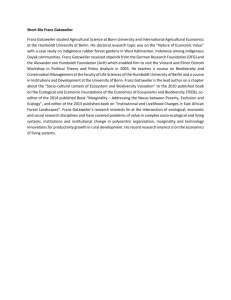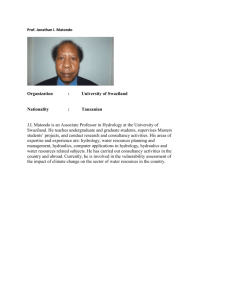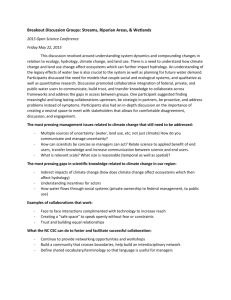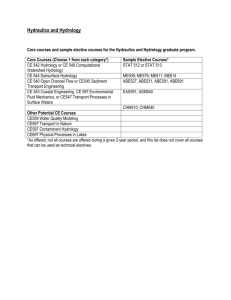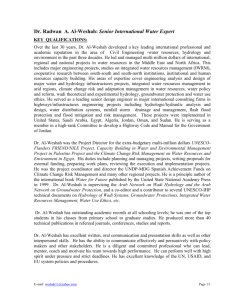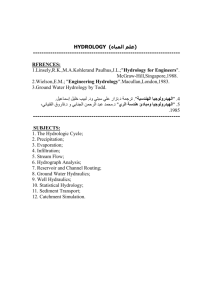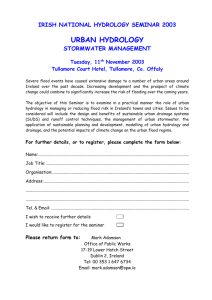Assimilation of snow data for ensemble streamflow prediction
advertisement
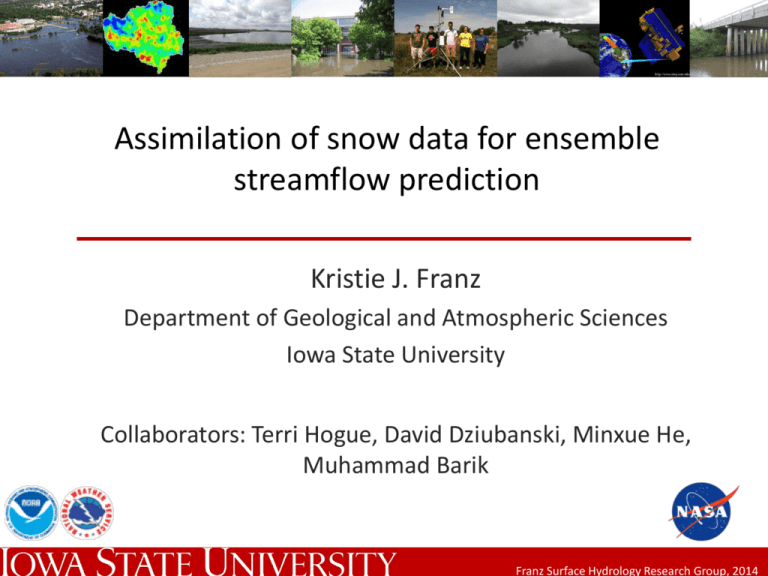
Assimilation of snow data for ensemble streamflow prediction Kristie J. Franz Department of Geological and Atmospheric Sciences Iowa State University Collaborators: Terri Hogue, David Dziubanski, Minxue He, Muhammad Barik Franz Surface Hydrology Research Group, 2014 Objectives & Motivation Advance and improve US National Weather Service hydrologic modeling and prediction • DA assimilation framework – Significant uncertainty in initial states in snow-dominated basins. • Applications of satellite-based remotely sensed data Data Assimilation not an established method in the NWS River Forecast System Several ongoing projects to evaluate DA and data products into forecasting Need systematic evaluation of new methods within operational forecasting framework Franz Surface Hydrology Research Group, 2014 Two SWE DA Studies 1. Ground-based SWE in snow dominated mountain basin (He et al., 2012; Franz et al., 2014) 2. Satellite SWE data in north-central US basins (Dziubanski , 2013; Dziubanski and Franz, in prep). Advanced Microwave Scanning Radiometer California Snow pillow sites Water supply forecasting Flood & streamflow forecasting Franz Surface Hydrology Research Group, 2014 National Weather Service modeling system SNOW17 Temperature Index Model (Anderson, 1973) Sacramento Soil Moisture Accounting Model (Burnash et al., 1973) Precipitation Temperature SNOW-17 SWE rain+melt PET demand • Modeling system used for short- and longterm streamflow predictions across US • Empirically-based snow model simulates accumulation and melt • Conceptual rainfallrunoff model simulates watershed residence and runoff Streamflow Franz Surface Hydrology Research Group, 2014 Ensemble Streamflow Prediction • Initialize models with current states • Run with past weather data (spanning forecast window) to generate streamflow scenarios. Forecasting dates where initial states are saved Year 1 Year 2 n = # historical scenarios Beginning of the hindcast Forecast window Year n Hindcasting: Ran models with and without DA and saved states for forecast dates. Forecasting dates evaluated: Jan1, Jan15, Feb1, Feb15, Mar1, Mar15, Apr1 (described in Day et al., 1985 & Franz et al. 2003) Franz Surface Hydrology Research Group, 2014 Hindcasting with Assimilation • Hindcasting with EnKF uses entire ensemble of initial states. • Ran models for each set of states with past weather data. Year 1 m number of assimilation ensembles Year 2 Ensemble Kalman Filter Year n n = # historical scenarios (n x m) ensemble traces Obs Forecast window Franz Surface Hydrology Research Group, 2014 Evaluation Probabilistic Metrics: Deterministic Metrics: BIAS Root Mean Square Error Normalized mean absolute error Continuous Ranked Probability Score Summary Statistics Accuracy Containing ratio Accuracy/Bias Discrimination & Reliability Plots Conditional Statistics Franz Surface Hydrology Research Group, 2014 Study 1 – California Sierra Nevada Mountains North Fork American River Basin (NFARB) Test: Assimilation of SWE data from 3 SNOTEL sites Data Period: WY1979WY2002 Snow: persistent in upper zone, transient or none in lower zone Area: 886 km2 Annual Ppt: 1514mm Annual Runoff: 837 mm (He et al., 2012, HESS; Franz et al., 2014, in press, JOH) Franz Surface Hydrology Research Group, 2014 Model & Assimilation Setup Upper basin Lower basin Precipitation SNOW-17 SNOW-17 Rain+Melt Rain+Melt SWE Assimilation Temperature PET SAC-SMA SAC-SMA Upper Q (0.33) Lower Q (0.67) Total Discharge • Basin modeled two elevation zones, 6-hourly • SWE assimilation in upper sub-basin only • weighted average of point SWE observations • Updating frequency 7 days • Forcing uncertainty based on uncertainty of SCF and PXTEMP parameters Franz Surface Hydrology Research Group, 2014 • Forecast analysis period is April 1 – July 31 – Forecasting begins Jan 1 • 26 hindcast samples for each forecast date – Non-DA: 58 member ensemble – DA: 5800 member ensemble (58 climate scenarios x 100 states) • Two sets of parameters examined • NWS RFC operational calibration • DREAM automatic calibration (considers parameter uncertainty) Franz Surface Hydrology Research Group, 2014 Ensemble mean Hindcasts (Jan 1 –Ap 1) No DA With DA RMSE (m-3) RMSE (m-3 /s) Ensemble mean Simulations (1991-1996) Simulated discharge: DA tests improved in terms of all metrics considered. See improved peaks. Bias (%) RFC Bias (%) RFC DREAM Hindcasts: DA improved bias and RFC-DA had lowest RMSE. But DREAM DA had higher RMSE than RFC w/no DA Franz Surface Hydrology Research Group, 2014 Ensemble Hindcasts • Hindcasts without DA have higher skill (CRPSS) • Containing ratios similar for all cases • DREAM parameters produce higher CRPSS Franz Surface Hydrology Research Group, 2014 What is happening? DA (red) shifts forecast probability away from observed (pink) towards higher flows. “Missed” observation. • Comparing all CDFS - 57% : non-DA closer match to the observations than DA - 23% : DA more accurate than non-DA - 20% showed no noticeable difference in CDFs. Franz Surface Hydrology Research Group, 2014 Additional comments • • • Hindcast skill improved as season progress Reliability and discrimination were not significantly changed by DA Best discrimination occurred for low flow (lowest 40%) – RFC calibration performed better for discrimination Franz Surface Hydrology Research Group, 2014 Study 2 – North Central US Test: Assimilation of SWE data AMSR-E Data Period: 2006-2011 Snow: persistent to north, transient and thin to south Land Use: North to south – forests/some wetlands to predominantly row crop Minnesota Wisconsin Iowa Area: 572 - 6330 km2 Annual Avg. Ppt: 846 mm Annual Avg. Runoff: 217 mm Dziubanski and Franz, in prep. Franz Surface Hydrology Research Group, 2014 Model & Assimilation Setup Single lumped basin Precipitation • Single, lumped basin SNOW-17 • SWE assimilation Rain+Melt SWE Assimilation Temperature PET SAC-SMA Unit hydrograph Total Discharge • Updating daily, when data available • Forcing uncertainty Precip: lognormal, mean 1 and SD 25 mm Temp: gaussian, mean 0 and SD 0.5oC • NWS RFC model parameters Franz Surface Hydrology Research Group, 2014 Data • AMSR-E Snow Water Equivalent (SWE). – 25 km resolution, daily – Microwave brightness temperature to calculate snow depth. Climatological, regional snow density to get SWE. – Error of 10-50 mm. (Tong and Velicogna, 2010; Kelly et al. 2003; Foster et al., 2005) – Factors affecting detection: size and number of snow grains, snow density, ice or free water, forest cover. Franz Surface Hydrology Research Group, 2014 AMSR-E Bias Correction • Bias evaluation using 1500 NOHRSC airborne observations (gamma radiation sensor) • Removed outliers based on the modified Z score method (Iglewicz and Hoaglin, 1993). • NOHRSC SWE • AMSR-E SWE • Bias • Bias correction and standard deviation of bias. • Avg. Bias: -17.91 mm • SD: 29.73 mm (uncertainty) Franz Surface Hydrology Research Group, 2014 • Forecasts 1st and 15th from January to April – 90 day outlooks • Only 6 hindcast samples for each forecast date – Non-DA: 61 member ensemble – DA: 6100 member ensemble - 61 climatologic scenarios x 100 replicate states Franz Surface Hydrology Research Group, 2014 Simulation results Feb 1-May 31 Mean absolute error No DA With DA • Decreased errors and Bias in 5 of 7 basins with DA • In some cases, there was little or no improvement during major melt periods (March/April) Franz Surface Hydrology Research Group, 2014 Simulated discharge and SWE Pecatonica R., WI - 2009 No DA With DA AMSR-E SWE Observed discharge • Observed low bias in SNOW17, generally corrected through DA • SNOW17 has slow melt compared to AMSR-E (sensor data errors in melt periods) Franz Surface Hydrology Research Group, 2014 Hindcasts: CRPSS 90-day maximum flow No DA With DA • Some improvement with DA in a few basins Clear Water River, MN • No difference with DA • Skillful forecasts • Well-modeled basin East Branch Pecatonica River St. Croix River, WI • Low skill • Poorly modeled basin Redwood River Franz Surface Hydrology Research Group, 2014 Ensemble mean hindcasts: Bias in daily flow No DA With DA Jan. 1 hindcasts Bias (%) • DA had little impact on Bias (or RMSE) in ensemble mean forecasts in most basins Feb. 1 hindcasts Mar. 1 hindcasts • N. Racoon, IA shown - DA produced greatest decrease in Bias for simulated daily flows & most impact on Bias in hindcasts - February 1 hindcasts had most improvement Forecast window Franz Surface Hydrology Research Group, 2014 Summary Remarks • Improvements in simulated discharge observed in both DA studies. • Apparent low SWE bias in SNOW17 for north-central US improved through assimilation of AMSR-E data • Additional work to consider AMSR-E errors needed • Few examples of improved hindcast performance when DA is applied compared to no DA • Climate uncertainty likely dominates in these examples (i.e. longterm forecasts) • Testing on short-term forecasts needed • Mismatch in evaluation of simulations with DA versus hindcasts with DA (e.g. daily flow versus seasonal volume) Franz Surface Hydrology Research Group, 2014 Summary Remarks Common assumption … • Application of new hydrologic methods will give better modeling results and lead to better forecasts. …difficult to prove, why? …how do we prove this and move operations forward? Franz Surface Hydrology Research Group, 2014 Questions? Acknowledgements • • • • • Mike DeWeese (NCRFC), Pedro Restrepo (NCRFC) Rob Hartman (CNRFC) NASA New Investigator Program grant #NNX10AQ77G NOAA National Weather Service grant # NA07NWS4620013 UCAR COMET grant Franz Surface Hydrology Research Group, 2014
